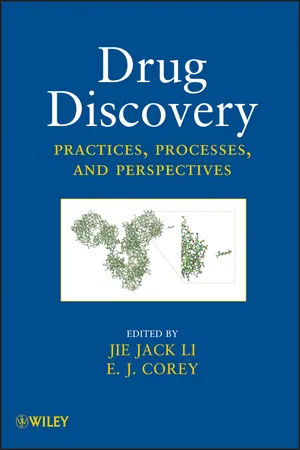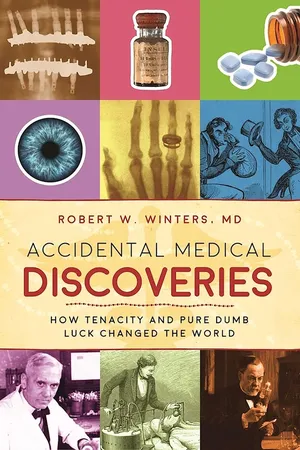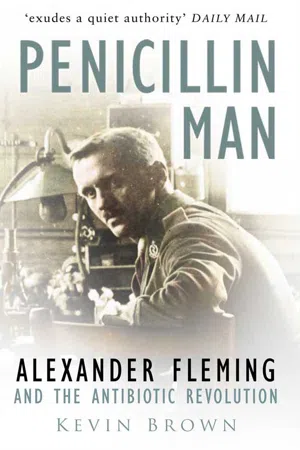History
Discovery of Penicillin
The discovery of penicillin is credited to Scottish scientist Alexander Fleming in 1928. While studying bacteria, Fleming noticed that a mold called Penicillium notatum had antibacterial properties, leading to the development of the first antibiotic. This breakthrough revolutionized medicine by providing an effective treatment for bacterial infections and laid the foundation for the development of numerous other antibiotics.
Written by Perlego with AI-assistance
Related key terms
5 Key excerpts on "Discovery of Penicillin"
- eBook - ePub
Medicating Modern America
Prescription Drugs in History
- Andrea Tone, Elizabeth Siegel Watkins(Authors)
- 2007(Publication Date)
- NYU Press(Publisher)
13 To understand the optimism which mounted thereafter and accompanied the antibiotics in their early years, it is worth reflecting on the process of discovery, which yielded such a rapidly widening family of products whose performance developed spectacularly within a few years.The story of penicillin with its well-known origin in an accident has come to overshadow the subsequent era of organized discovery.14 Penicillin was of course the first to be used widely, and its numerous well-attested benefits gave enormous encouragement to those who would develop new drugs. The new medicine could cure syphilis and gonorrhea within days and treat wounds, which were already infected and were untreatable with sulfa drugs. It had however particular restrictions on its range and it proved difficult to enhance. Penicillin could not affect the gram-negative bacteria such as salmonella and E. coli , which affect the digestive system. Nor was it powerful against the most feared of infectious disease, tuberculosis. Moreover, penicillin had been the product of an accidentally encountered mold and whereas minor modifications could be made, until the late 1950s, it proved difficult to widen substantially its range of activity, either through chemical or biological means. So while production was rapidly enhanced, the fundamental therapeutic benefits of penicillin itself remained, for a decade, difficult to grow.The family of antibiotics was therefore developed at first through another route. As early as 1939, the drug gramicidin, albeit itself less therapeutically effective than penicillin, had been the successful outcome of a systematic study of antibacterial compounds produced by soil organisms. This was the work of René Dubos of New York’s Rockefeller Institute who first announced his success in September 1939. From 1940, a research program in the agricultural faculty of Rutgers University in New Brunswick headed by Waksman who had been Dubos’s teacher, sought and found several other antibiotics produced by soil-inhabiting actinomycetes, a family of organisms that lie between single cell bacteria and fungi.15 - eBook - ePub
Drug Discovery
Practices, Processes, and Perspectives
- Jie Jack Li, E. J. Corey(Authors)
- 2013(Publication Date)
- Wiley(Publisher)
6,7 This review will briefly describe the history of small-molecule antibiotics, challenges to antibacterial drug discovery, briefly summarize key representative antibiotic classes, and suggest promising future directions to develop new and effective antibiotics.2 The Rise and Decline of Antibiotics
The modern era of antibacterial drug discovery began with the 1929 publication by Alexander Fleming on the observation that a penicillium mold inhibited the growth of various bacteria on an agar plate.8 He stated, “for convenience and to avoid the repetition of the rather cumbersome phrase ‘Mould broth filtrate.’ The name ‘penicillin’ will be used.” Despite this early discovery, work slowed on penicillin until mass production initiated in the early 1940s during World War II. Penicillin is an irreversible inhibitor of penicillin binding proteins (PBPs), which are necessary for bacterial cell wall formation.9 Separately, Gerhard Domagk at I. G. Farben in Germany showed that a sulfonamide dye was effective in treating bacterial infections in mice in 1931.10,11 A 1932 patent on the discovery was filed, which included the drug prontosil, and additional publications were made in 1935. At this time it was realized that the dye was a prodrug, and the actual active agent was para-aminobenzenesulfonamide, the first member of the sulfa class of antibiotics. Drugs of this type are now known to inhibit bacterial folate synthesis and thus interfere with DNA replication. Although not as effective as penicillin, prontosil became the first commercially available antibiotic in 1935.The discovery of novel antibiotics was central to the growth of pharmaceutical companies in the 1940s and 1950s. Many began this process through helping to create a large-scale fermentation and isolation of penicillin to aid in the war effort. Subsequently, they developed multiple new antibiotics over the course of the next 2–3 decades.12 Most of these were isolated natural products, which, like penicillin, were isolated and scaled through fermentation. Due to the ubiquity of bacteria in nature, and in many cases their constant threat to other life forms, not surprisingly, nature had created many unique ways of killing bacteria through a variety of different mechanisms. This included targeting bacterial PBPs, which interfere with cell wall formation; the ribosome, interfering with protein biogenesis; DNA gyrase and topoisomerase IV, which causes bacterial death through DNA aberrations; and bacterial membrane disruptors, to name a few. Great advantages in the pursuit of discovering antibiotics are the highly predictive in vitro and in vivo preclinical disease models, resulting in a lower attrition rate in the clinic.13 - eBook - ePub
Accidental Medical Discoveries
How Tenacity and Pure Dumb Luck Changed the World
- Robert W. Winters(Author)
- 2016(Publication Date)
- Skyhorse(Publisher)
Many years earlier, Edward Jenner had accidentally overheard a conversation in which he learned that a cowpox infection on the hands of milkmaids conferred protection against the future development of smallpox. Subsequently, the folklore provided abundant confirmation in England and in Europe. But even though he did not know how that was accomplished, he concluded that the causative agent, which he called a virus, was transferable, since the only transmission to the milkmaids had to be the virus carried from the teats of the cow to the milkmaids’ hands. Once again, we see a prepared mind at work.REFERENCESBarquet, N. et al. “Smallpox: the triumph over the most terrible of the ministers of death.” Ann Intern Med. 127 (1997), 635–642.Friedman, M., and G. W. Friedland. “Edward Jenner and Vaccination.” Chap. 4 in Medicine’s 10 Greatest Discoveries. New Haven, CT: Yale University Press, 1998.Henderson, D. A. et al. “Working Group on Civilian Biodefense. Smallpox as a biological weapon: medical and public health management.” JAMA 22 (1999), 2127–2137.World Health Organization. Global Commission for Certification of Smallpox Eradication. The Global Eradication of Smallpox: Final Report of the Global Commission for the Certification of Smallpox Eradication. Geneva: World Health Organization, 1980.Passage contains an image CHAPTER 10 Penicillin: The Crucial Role of Weather The phrase that heralds a new discovery is not “Eureka!” It’s “That’s funny.”
—Isaac Asimov, a uthorIntroductionT he story of penicillin has been told many times, often superficially and nearly always inaccurately. The following is a more complete account of this amazing discovery by Alexander Fleming. It deals with the critical role that the London weather played during September 1928. The unsung hero of this tale is Howard Florey, leader of the Oxford Group, whose great contribution was to bring penicillin from the laboratory to the bedside.The DiscoveryIn 1928, Dr. Alexander Fleming, nicknamed “Flem,” was happily working in a cramped lab in St. Mary’s Hospital in London. Fleming’s job was to isolate the bacteria that were causing diseases in patients. To do this, he would take a small, circular, covered glass plate called a Petri plate that was filled with nutrients on which bacteria would grow. Fleming would quickly lift the plate’s lid and smear a sample of some infectious fluid like pus or throat washings that had come from one of the patients. Speed was essential to minimize any contaminating bacteria or molds in the air from accidently dropping onto the plate when it was exposed. He would then put the plate into a warm (37°C) incubator to speed the growth of the bacteria. The next day the bacterial growth would have spread all over the plate. Fleming would then identify the bacteria under a microscope and determine to which bacterial family it belonged. He sent his reports back to the doctors in the hospital, who depended on them to guide the treatments of their patients. - eBook - ePub
The Greatest Benefit to Mankind
A Medical History of Humanity
- Roy Porter(Author)
- 2017(Publication Date)
- Fontana Press(Publisher)
* bacteria as staphylococci, streptococci, gonococci, meningococci, diphtheria bacillus and pneumococci, it had no toxic effect on healthy tissues and did not impede leucocytic (white cell) defence functions. This weighed heavily with Fleming in view of his general opinions on wound treatment; penicillin appeared not just strong but safe. Yet it had no effect on Gram-negative bacteria, including those responsible for cholera and bubonic plague; it was hard to produce and very unstable, and thus did not seem clinically promising. Fleming did nothing, and the scientific community paid little heed.Ten years later, however, a team of young Oxford scientists, led by the Australian Howard Florey (1898–1968), head of the Dunn School of Pathology, and including the ebullient biochemist Ernst Chain (1906–79), a refugee from Nazi Germany, launched a research project on microbial antagonisms. Combing the scientific literature for antibacterial substances, Chain found Fleming’s report, and the team began to grow P. notatum, soon encountering the difficulties involved in isolating the active ingredient from the liquid the mould produced – only one part in two million was pure penicillin. Another biochemist in the team, Norman Heatley (b. 1911), devised improved production techniques. They continued purifying the drug and began testing. On 25 May 1940 they inoculated eight mice with fatal streptococci doses, and four were then given penicillin. By next morning, all had died except the four treated mice.Florey seized upon the drug’s potential; his department went into production, using, in best Heath-Robinson manner, milk churns, lemonade bottles, bedpans and a bath tub until they thought they had enough to try it on a patient – a policeman near death from staphylococcal septicaemia following a scratch while pruning his roses. There was, in fact, so little available that his urine was collected to recycle as much of the drug as possible. By the fourth day, he had improved remarkably, but then the penicillin ran out and he died. - eBook - ePub
- Kevin Brown(Author)
- 2005(Publication Date)
- The History Press(Publisher)
EIGHT Challenge for AmericaT he end of the Second World War found Fleming back in the United States from which he had made a mad dash home to London at the outbreak of war six years previously. Then he had been one of a number of delegates at a microbiological congress. Now, his second visit to North America took on more of the character of a triumphal tour, as the modest Scot whose discovery had seemingly vanquished infection was greeted everywhere with all the honour more usually given to a victorious general touring the battlefields on which his reputation had been won. Universally he was greeted as the man who had given the world penicillin, though he had been warned in advance not to expect such treatment: ‘I had been told in many quarters it was believed that penicillin originated in America but that I cannot accept, as everywhere in the public press as well as in scientific quarters, I have received my full share of credit for the initiation of the work.’1 For Fleming it was the opportunity to see for himself the great advances that had been made in North America to enable mass production of penicillin to become a reality.What struck Fleming most from his triumphant American tour was that ‘It is evident that they think more of penicillin in America than in England’.2 Everywhere he went in the summer of 1945 he was lionised during a series of press conferences, radio interviews and public lectures orchestrated for him by John Cameron, his minder from the British Mission, who confessed that he had fallen ‘completely under his spell’.3 His American tour was a success from the moment he set sail on the Aquitania and gave a lecture on the Discovery of Penicillin to his fellow travellers in mid-voyage. Despite his dislike of such lecturing, he was coming to tailor what he said to his audience, increasingly non-medical. He also joined his shipmates in conversation though was perhaps a better listener than talker.4
Learn about this page
Index pages curate the most relevant extracts from our library of academic textbooks. They’ve been created using an in-house natural language model (NLM), each adding context and meaning to key research topics.




